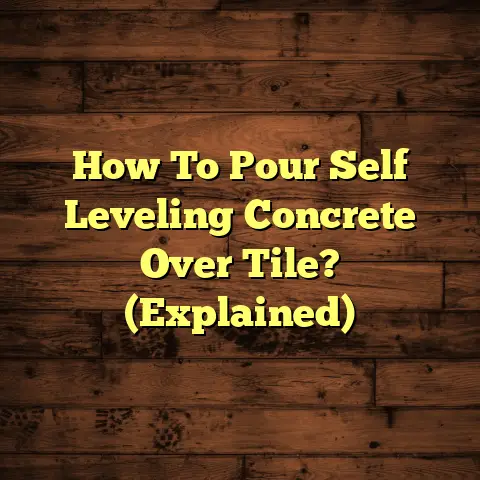Seal Wood Floor Cracks: DIY (6 Tools You’ll Need!)
Let’s bust a common myth right away: wood floors are NOT impervious to damage. I can’t tell you how many times I’ve heard, “Oh, it’s wood, it’ll last forever!”
While they’re definitely durable, they need love and attention, just like any other part of your home. Ignoring them can lead to some serious headaches, including costly repairs down the line.
Think of your wood floors like your skin. They’re constantly exposed to the elements – humidity, temperature changes, foot traffic, even your pet’s claws! All of this takes a toll, and over time, you might start noticing those dreaded cracks.
But don’t panic! Addressing these cracks promptly is key to maintaining the beauty and integrity of your flooring. And guess what? You can totally tackle this yourself!
Let’s dive into how to seal those cracks and keep your wood floors looking their best.
Understanding Wood Floor Cracks
So, what causes those pesky cracks to appear in the first place?
Think of wood as a living, breathing material. It expands and contracts with changes in humidity and temperature. In the winter, when the air is dry, wood shrinks, leading to gaps and cracks. In the summer, it absorbs moisture and expands again.
Other culprits include:
- Foot Traffic: All that walking, running, and dancing takes its toll.
- Heavy Furniture: Dragging furniture across the floor can cause scratches and cracks.
- Lack of Maintenance: Neglecting to properly clean and maintain your floors can accelerate wear and tear.
Now, not all cracks are created equal. You might see:
- Surface Cracks: These are small, hairline cracks that only affect the surface finish.
- Structural Cracks: These are deeper, wider cracks that extend into the wood itself. They can compromise the stability of the floor.
It’s important to identify the type of crack you’re dealing with before you start any repairs.
The Importance of Sealing Cracks
Why bother sealing those cracks anyway? Can’t you just ignore them?
Trust me, you don’t want to ignore them. Sealing cracks offers a ton of benefits:
- Prevents Moisture Infiltration: Cracks are like open doors for moisture. Moisture can lead to mold growth, wood rot, and even structural damage.
- Reduces the Risk of Further Damage: Unsealed cracks can widen and deepen over time, making the problem even worse.
- Maintains Aesthetic Appeal: Let’s face it, cracks are unsightly. Sealing them restores the beauty of your wood floors.
- Prevents Pest Infestations: Insects like to hide in cracks and crevices. Sealing them denies them a place to call home.
- Increases Property Value: Well-maintained wood floors are a major selling point. Sealing cracks shows that you care about your home.
I’ve seen firsthand what happens when homeowners neglect cracks. It’s not pretty. Mold, warped boards, and even insect infestations are just some of the consequences.
Don’t let this happen to you!
DIY Sealing Process Overview
The good news is that sealing wood floor cracks is a totally manageable DIY project.
You don’t need to be a professional contractor to get the job done. With the right tools, materials, and a little elbow grease, you can restore your wood floors to their former glory.
Here’s a quick overview of the process:
- Clean: Thoroughly clean the area around the crack.
- Fill: Apply wood filler to the crack.
- Sand: Sand down the filler to create a smooth surface.
- Stain (Optional): If necessary, stain the filled area to match the surrounding wood.
- Finish: Apply a clear coat finish to protect the repaired area.
Sounds simple, right? It is! But having the right tools will make the job much easier and more effective.
Let’s talk about the essential tools you’ll need.
Essential Tools for DIY Crack Sealing
Okay, let’s get down to business. Here are the six essential tools you’ll need to seal those wood floor cracks like a pro:
Tool 1: Wood Filler
Wood filler is your best friend when it comes to filling cracks. It’s a paste-like substance that hardens as it dries, creating a solid, durable repair.
But not all wood fillers are created equal. You’ll find two main types:
- Water-Based Wood Filler: This type is easy to work with, dries quickly, and is low in VOCs (volatile organic compounds). It’s a good choice for small to medium-sized cracks.
- Solvent-Based Wood Filler: This type is more durable and water-resistant than water-based fillers. It’s a better choice for larger cracks or areas that are exposed to moisture.
Choosing the Right Color:
This is crucial! You want the filler to blend seamlessly with your wood floor.
Many wood fillers come in a variety of colors to match different wood species.
I always recommend testing the filler in an inconspicuous area before applying it to the crack. This will give you a chance to see if the color is a good match.
If you can’t find a perfect match, you can mix different colors of wood filler together to create a custom blend.
Pro Tip: For deeper cracks, apply the wood filler in layers, allowing each layer to dry completely before applying the next. This will prevent the filler from shrinking and cracking.
Tool 2: Putty Knife
A putty knife is a flat, flexible blade that’s used to apply wood filler to the crack. The flexibility of the blade allows you to smooth the filler evenly and accurately.
Putty knives come in a variety of sizes. For most wood floor crack repairs, a 1-2 inch putty knife will do the trick.
Choosing the Right Size:
- Small Cracks: A smaller putty knife will give you more control and precision.
- Large Cracks: A larger putty knife will allow you to apply the filler more quickly.
When using a putty knife, hold it at a slight angle to the surface of the floor. This will help you to avoid gouging the wood.
Pro Tip: Keep your putty knife clean! Wipe it off frequently with a damp cloth to prevent the filler from drying on the blade.
Tool 3: Sandpaper (Various Grains)
Sanding is an essential step in the crack sealing process. It smooths out the filled area and blends it seamlessly with the surrounding wood.
You’ll need a variety of sandpaper grits to achieve a smooth finish:
- Coarse Grit (80-100): Used to remove excess filler and level the repaired area.
- Medium Grit (120-150): Used to smooth out the scratches left by the coarse grit sandpaper.
- Fine Grit (180-220): Used to create a smooth, polished finish.
How to Sand Effectively:
- Start with the coarse grit sandpaper and work your way up to the fine grit.
- Sand in the direction of the wood grain.
- Use light pressure and avoid sanding too much in one area.
- Vacuum up the sanding dust frequently.
Pro Tip: Wrap the sandpaper around a sanding block for a more even and controlled sanding experience.
Tool 4: Wood Stain (if necessary)
Sometimes, even if you choose the right color of wood filler, it might not perfectly match the surrounding wood. This is where wood stain comes in.
Wood stain adds color to the filled area, helping it to blend seamlessly with the rest of the floor.
When is Wood Stain Necessary?
- The wood filler is a different color than the surrounding wood.
- The wood floor has faded or changed color over time.
- You want to create a more uniform look across the floor.
Tips on Application and Drying Times:
- Choose a wood stain that matches the color of your wood floor.
- Apply the stain evenly with a brush or cloth.
- Wipe off any excess stain with a clean cloth.
- Allow the stain to dry completely before applying a clear coat finish.
Pro Tip: Test the stain in an inconspicuous area before applying it to the repaired area. This will give you a chance to see if the color is a good match.
Tool 5: Clear Coat Finish
A clear coat finish is a protective layer that’s applied over the repaired area. It protects the wood from scratches, moisture, and UV damage.
Applying a clear coat finish is crucial after sealing cracks for a few reasons:
- Protection: It shields the wood filler and surrounding wood from wear and tear.
- Durability: It extends the lifespan of the repair.
- Aesthetics: It enhances the look of the floor and provides a uniform sheen.
You have several options for clear coat finishes:
- Polyurethane: A durable and water-resistant finish that’s available in oil-based and water-based formulas.
- Water-Based Finish: Low in VOCs and dries quickly.
- Oil-Based Finish: Provides a warm, amber hue and is very durable.
Choosing the Right Finish:
The best finish for you will depend on your needs and preferences.
- Durability: If you have heavy foot traffic, choose a durable finish like polyurethane.
- VOCs: If you’re concerned about VOCs, choose a water-based finish.
- Appearance: If you want a warm, amber hue, choose an oil-based finish.
Pro Tip: Apply multiple thin coats of finish rather than one thick coat. This will prevent drips and runs and create a more even finish.
Tool 6: Paintbrush or Roller
A paintbrush or roller is used to apply the clear coat finish evenly and effectively.
Choosing the Right Tool:
- Paintbrush: A good choice for small areas or intricate details.
- Roller: A good choice for larger areas.
Tips on Cleaning Tools After Use:
- Clean your paintbrush or roller immediately after use.
- Use the appropriate solvent for the finish you used.
- Store your paintbrush or roller properly to prevent it from drying out.
Pro Tip: Use a high-quality paintbrush or roller for the best results. Cheap brushes and rollers can leave streaks and bubbles in the finish.
Step-by-Step DIY Process for Sealing Cracks
Alright, now that you’ve got your tools, let’s get to work! Here’s a step-by-step guide on how to seal those wood floor cracks:
Step 1: Preparation
- Clean the area: Vacuum and wipe down the area around the crack with a damp cloth. Make sure the area is free of dust, dirt, and debris.
- Assess the crack: Determine the size and depth of the crack. This will help you choose the right type of wood filler.
Step 2: Application of Wood Filler
- Apply the wood filler: Use a putty knife to apply the wood filler to the crack. Overfill the crack slightly, as the filler will shrink as it dries.
- Smooth the filler: Use the putty knife to smooth the filler and blend it with the surrounding wood.
Step 3: Sanding
- Allow the filler to dry: Allow the wood filler to dry completely according to the manufacturer’s instructions.
- Sand the filled area: Use coarse grit sandpaper to remove excess filler and level the repaired area. Then, use medium grit sandpaper to smooth out the scratches. Finally, use fine grit sandpaper to create a smooth, polished finish.
Step 4: Staining (Optional)
- Apply the stain: If necessary, apply wood stain to the filled area to match the surrounding wood.
- Wipe off excess stain: Wipe off any excess stain with a clean cloth.
- Allow the stain to dry: Allow the stain to dry completely according to the manufacturer’s instructions.
Step 5: Applying a Finish
- Apply the finish: Use a paintbrush or roller to apply a clear coat finish to the repaired area.
- Allow the finish to dry: Allow the finish to dry completely according to the manufacturer’s instructions.
- Apply additional coats: Apply additional coats of finish as needed.
Common Pitfalls to Avoid:
- Using the wrong type of wood filler: Choose a wood filler that’s appropriate for the size and depth of the crack.
- Not allowing the filler to dry completely: Make sure the filler is completely dry before sanding.
- Sanding too aggressively: Use light pressure and avoid sanding too much in one area.
- Applying too much finish: Apply multiple thin coats of finish rather than one thick coat.
Conclusion
Sealing cracks in your wood floors is a manageable DIY project that can save you money and preserve the beauty of your flooring.
By following these steps and using the right tools, you can restore your wood floors to their former glory.
So, what are you waiting for? Grab your tools, roll up your sleeves, and tackle those cracks! Your wood floors will thank you for it.
And remember, a little bit of maintenance goes a long way in preserving the beauty and longevity of your wood floors. Don’t neglect them!





